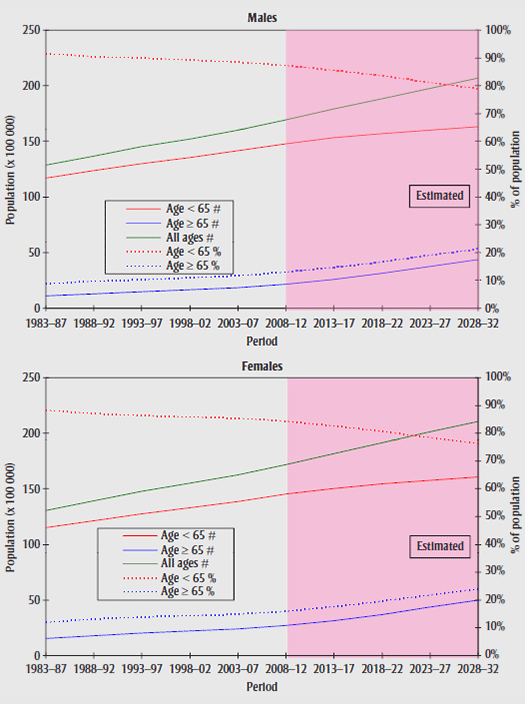Chapter 1: Cancer incidence in Canada: trends and projections (1983-2032) - HPCDP: Volume 35, Supplement 1, Spring 2015
Chapter 1: Introduction
A prominent characteristic of current sociodemographic changes in Canada is the accelerated growth in the number and proportion of seniors. Figure 1.1 shows that the percentage of men aged 65Endnote * or older is projected to increase from 12% in 2003–2007 to 21% in 2028–2032 and of women the same age from 15% to 24% in the same period. The increase in the number of older adults is a consequence of reduced mortality rates in all age groups and the aging of the baby boomer generation. This demographic trend is expected to result in a significantly higher number of cancer diagnoses and therefore demand for health care services. Defining the expected societal burden of cancer can provide evidence-based input into planning cancer control programs, leveraging resources to meet future health care needs and reducing the expected burden of cancer in Canada.
FIGURE 1.1
Historic and projected growth in average annual population in Canada by age, 1983–2032

[FIGURE 1, Text Equivalent]
Figure 1.1 shows the Canadian population is expected to grow and age. The average annual Canadian population is projected to increase from 32.3 million in 2003-2007 to 41.7 million people by 2028-2032 (in a medium-growth scenario). The average annual number of Canadians aged 65+ is predicted to more than double, from 4.2 million in 2003-2007 to 9.4 million in 2028-2032. Moreover, it is expected that the growth in population in males aged 65 or older will be greater than that in females (increases of 137% vs 109%).
We quantify the future burden of cancer from two perspectives: age-standardized rate and the number of new cancer cases. Changes in incidence rates communicate changes in risk of developing cancer over time. The future number of new cases is a consequence of changes both in the cancer rates and in the population size and composition.
The main source of estimates of expected case counts and rates for common cancer sites in the current year for Canada and the provinces and territories is the annual Canadian Cancer Statistics report.Endnote 1 These estimates provide important information for cancer control planners, public policy analysts, and provincial and territorial health care professionals who need to know the relative burden of different types of cancer and for different geographical regions.
Currently, there are no widely available long-term national projections for Canada, whereas several other developed countries have documented their profiles.Endnote 2, Endnote 3, Endnote 4, Endnote 5 To map out such a possible future cancer scenario, this monograph presents estimates of cancer incidence frequencies and rates in Canada for 25 cancer sites by geographical area, sex and age group through 2028–2032.